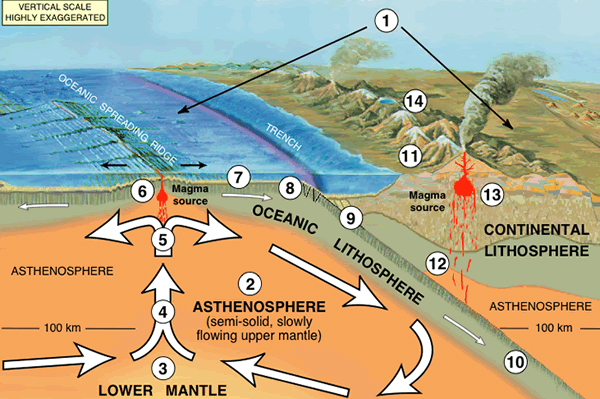
Rethinking Earth's Most Massive Eruption

The origins of the lavas pouring out of Earth's largest ongoing volcanic eruptions are being challenged in this week's Nature. The eruptions are along the mid-ocean ridges that run for tens of thousands of miles though the deep sea. These are spreading centers where the Earth's crust is being pulled apart and partially melted rock wells up to continuously fill the voids – building vast amounts of new oceanic crust. But no one is arguing that part of the story.
What is in question is just how well we are interpreting the lavas from those eruptions and what they tell us about the rocks down in the Earth's mantle. This is a big deal, because the rocks at ocean spreading centers are among the very few ways we can study the Earth's mantle. The trick has always been to figure out what changes the deep sea lavas have undergone between the mantle and the time they erupt. Geochemists read the mineral structure of lava rocks to figure what the molten material was like when it was in the mantle.
NEWS: Earth's 'Hum' Helps Probe Planet's Interior
For a long time geologists centered this reverse engineering around a process called fractional crystallization. I remember this process initially giving me a little headache when I was a geology undergraduate, but it's really pretty intuitive if you spend any time in a kitchen or chemistry class. You take a pot full of hot magma and start to cool it so that some minerals solidify into crystals and sink to the bottom. Then keep cooling it so that more crystals of various kinds of minerals form and drop out and there is less and less melted rock.
What happens during this process is that the still melted part of the mix loses a lot of elements that are easy to make crystals with. What's left in the melt are a bunch of elements that are lousy crystal makers: aptly called “incompatible elements.” These tend to be rare elements like strontium, neodymium and hafnium, and they provide clues to the origins of the magma in the mantle.
PHOTOS: World's Rarest Gemstones
When the magma is entirely erupted and cooled, what you end up with in the pot – or making up the oceanic crust – depends a lot on what mix of elements you started with (the rocks it came from in the mantle) and how much time you took cooling it down, and whether you added a little fresh magma to the mix during the process. So what you get out of the pot should reflect what you put in – which should reflect regional variations in the mantle. Right?
Sign up for the Live Science daily newsletter now
Get the world’s most fascinating discoveries delivered straight to your inbox.
This is where a new paper in Nature by geoscientists Hugh O'Neill and Frances Jenner comes into play. They have discovered an unexpected worldwide pattern in those incompatible elements that hints at a larger uniform process producing the magmas that make up the oceanic crust of the Earth; a “cycling of magma through the global ensemble of magma chambers,” as they describe it.
PHOTOS: Up Close With a Restless Hawaiian Volcano
And why does this matter? Because, as geoscientist Albrecht Hofmann explained in a Nature commentary, it means we have to re-examine the process behind the Earth's most voluminous eruptions. That kind of fundamental change of course doesn't happen every day.
This story was provided by Discovery News.










